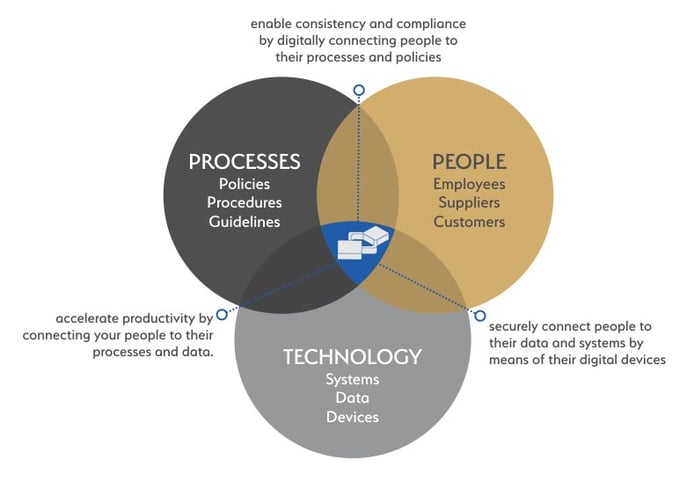It seems that every industry is talking about digital transformation, which is often viewed as going paperless. Digital business transformation would be better described as embracing digital innovation in order to achieve strategic business objectives, rather than merely using technology to support an organisation’s traditional approach.

In truth, digital innovation has been around for years. Every innovation, from the original transistor (1947) to the modern smartphone (2017), has played their part in the evolution of the digital age. So why is digital-everything a buzzword now? The answer is twofold:
The Pace of Digital Adoption is Increasing
As with previous innovations in history, the easier communication and collaboration is made by the new technology, the faster the adoption curve is likely to be. To give you some context, it took the telephone 75 years to reach 50 million users, while it took Pokémon Go 16 days to achieve 50 million downloads.

Modern communication platforms are faster, easier to use, and more connected than ever, this means that business data can be transferred quickly and to a wider assortment of people. Which in turn means, customers move faster, want results quicker, and demand communication across a wider range of mediums.
Organisations may feel pressurised to add more and more technologies to the mix in the hopes of keeping up, but without a solid plan of execution, they are likely to spend a lot of money and see few positive results. To successfully ride the technology wave, organisations need to combine digital activity with strong leadership, in order to turn technology into transformation.
Instead of asking what an organisation can do with a piece of technology, a true innovator:
- Knows what they want to achieve;
- Understands what their market wants;
- Sculpts their business processes to support their strategic objectives;
- Uses select technology enablers to achieve these objectives.
Organisations should be cautious of the “charge it the card” attitude towards implementing business applications. It has become very easy for users to sign up for a variety of subscription applications in the hopes that a new application will help to them achieve their objectives. Without some guidance and C-level management, corporations run the risk of creating a complex and complicated application landscape, where cohesive data and risk management are virtually unattainable goals.
The second reason why digital is the buzzword of the moment?
Digital Is Personal
The increasing speed and ease of communication is proportionate to how personalised the messaging system is. This is at the core of why digital is so transformational. It’s personal.
Digital data is everywhere, affecting our daily lives. It’s on our smartphones, our GPS, our social media. It’s affecting our shopping habits, our health choices, our travel patterns, even our collective humour. Few things travel as fast as a meme whose time has come.
The rapid adoption of technology has had another side-effect; users are continuously generating and sharing huge amounts of data, some of which is significant to business. The key to successful innovation is identifying which pieces of data are useful to your business and understanding how to use them. Do you really still need to collect your customer’s fax number?
Data Without Action Is Ineffective
The real power of data is what your organisation does with the data once a user hits the submit button, or a sensor picks up an irregularity. This is where business process management (BPM) and the appropriate technology enablers are key.
For your organisation to achieve an outcome, many complex and interconnected processes may contribute. Every change to these processes has consequences, which without a holistic view of the business, can be unpredictable. With a process-modelling tool such as Collaborate, innovators can map out the entire lifecycle of a process across business units and systems; add quantifiable metrics to each step; and safely test new ideas before implementing changes companywide.
For processes to work, people need to adhere to them. Again, we look to technology for a solution. Digital process automation software, like FlowCentric Processware, allows organisations to develop and manage highly complex process flows, which are orchestrated across business units, systems, and devices.
Digital process automation allows you to manage organisational outcomes, not simply the individual processes that contribute to these outcomes.
The benefits of transforming your business through better use of data and digital tools are widely accepted in the business world. Across the board, digital business transformation is helping organisations increase revenue, reduce costs and meet operational objectives.
For many business owners, digital transformation is something that they know they have to do, but keep putting it off. Unfortunately, for every year that these businesses don’t move forward, the gap between them and their transforming competition gets wider.
----^----
Do you want to transform your business?
Request a call and we’d be happy to help you.



